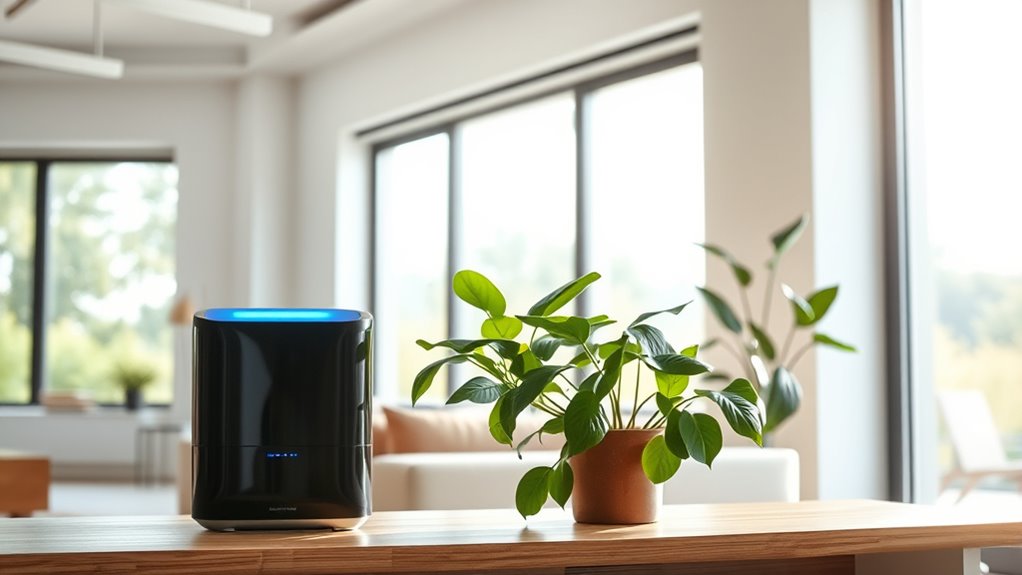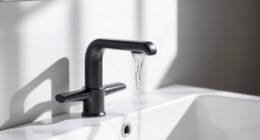Indoor air quality is vital for your health because it affects your respiratory system, immune response, and overall well-being. Pollutants like VOCs, dust, mold, and bacteria can cause allergies, asthma, and infections. Poor ventilation and contaminated air may lead to long-term health issues. Keeping your indoor environment clean, ventilated, and properly monitored can greatly improve your health. To learn how you can create a healthier space, explore the essential strategies that make a difference.
Key Takeaways
- Poor indoor air quality can cause respiratory issues, allergies, and worsen asthma symptoms.
- Exposure to indoor pollutants like VOCs and dust increases infection risk and long-term health problems.
- Maintaining proper ventilation and air purification reduces harmful pollutants and improves overall health.
- Indoor mold, mildew, and allergens can trigger chronic respiratory conditions and weaken immunity.
- Good IAQ supports better sleep, mental clarity, and overall well-being by ensuring cleaner, healthier indoor environments.
Understanding Indoor Air Quality and Its Components
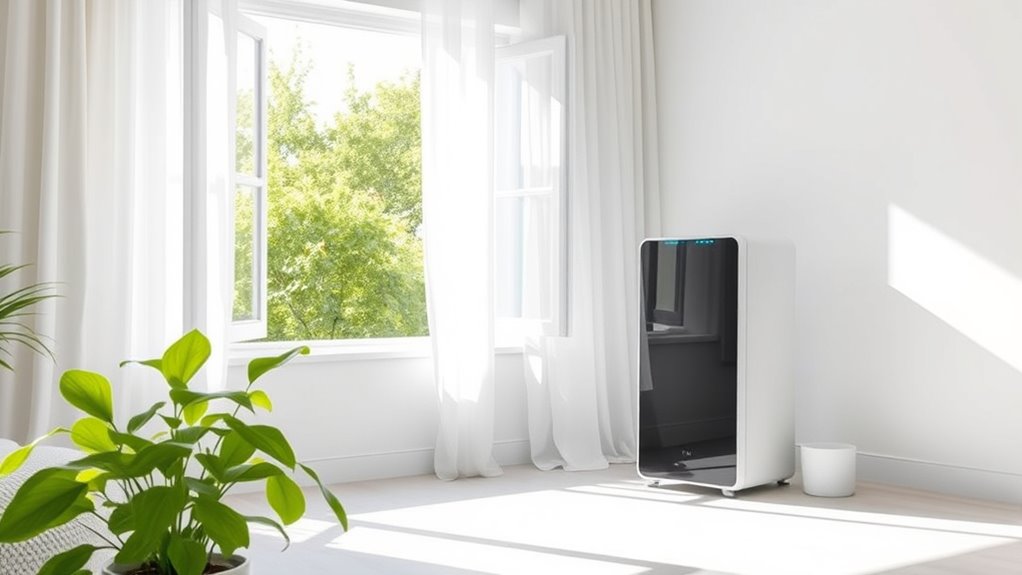
Indoor air quality (IAQ) refers to the condition of the air inside your home or workplace, and it directly affects your health and comfort. A key component of IAQ is air exchange, which involves replacing stale indoor air with fresh outdoor air to reduce pollutant levels. Proper air exchange helps control pollutant sources such as cooking fumes, tobacco smoke, pet dander, and household chemicals. These pollutant sources release particles and gases that can accumulate if the air isn’t regularly refreshed. Understanding how air exchange works allows you to improve IAQ by increasing ventilation or using air purifiers. Monitoring pollutant sources and managing airflow are essential steps to maintaining a healthier indoor environment, ultimately protecting your health and enhancing comfort. Additionally, implementing ventilation strategies can significantly improve overall air quality, especially in spaces with limited natural airflow. Incorporating self watering plant pots can also contribute to improved indoor air quality by increasing humidity and reducing airborne pollutants. Proper ventilation is especially important in enclosed spaces to prevent the buildup of harmful substances, as supported by advances in AI-powered air quality monitoring. Regular maintenance of air filtration systems and awareness of indoor pollutant levels are also crucial for sustaining a healthy indoor environment. Recognizing that some dog breeds, such as the Black Golden Retriever, are known for their friendly and loyal nature, can also positively influence your home’s atmosphere by fostering a calm and welcoming environment.
Common Indoor Pollutants That Affect Your Health
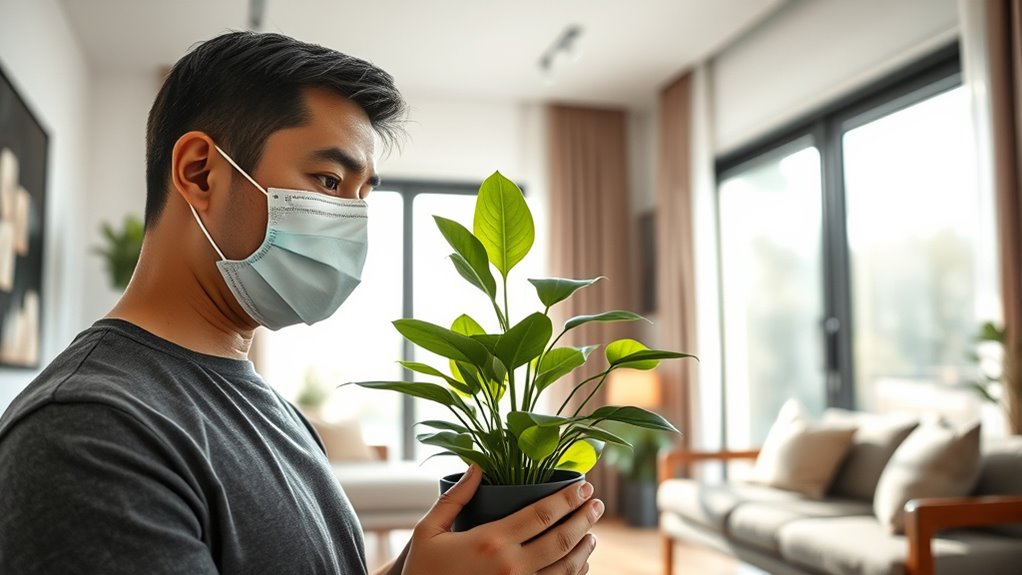
You’re exposed to various indoor pollutants that can impact your health daily. Volatile Organic Compounds (VOCs), allergens, dust, mold, and mildew are common culprits. Recognizing these pollutants helps you take steps to improve your indoor air quality. In environments with poor ventilation, pollutant levels can increase, further compromising health. Additionally, the presence of Vetted – 1st Home Theatre Projector can contribute to indoor air quality issues if not properly maintained, as dust and mold can accumulate on its surfaces. Using an air purifier with HEPA and activated carbon filters can effectively reduce these airborne contaminants and improve your living environment. Wisdom from ancient cultures, such as the importance of harmony and balance, reminds us to maintain a healthy environment for overall well-being. Embracing personal growth through mindful living can also positively influence your indoor environment by fostering healthier habits.
Volatile Organic Compounds (VOCs)
Volatile Organic Compounds (VOCs) are a group of chemicals emitted as gases from various household products and building materials, and they can pose significant health risks. VOC sources include air fresheners, paints, cleaning supplies, and furniture, all releasing chemical emissions into your indoor environment. These emissions can cause short-term effects like headaches, dizziness, and eye irritation, and long-term exposure may lead to more serious health issues such as respiratory problems and even certain cancers. Understanding where VOCs originate helps you take steps to reduce your exposure. Proper ventilation, choosing low-VOC products, and avoiding unnecessary chemical use are essential in minimizing VOC levels in your home. Additionally, indoor air quality can be affected by the presence of VOCs, which emphasizes the importance of maintaining good ventilation and air purification practices. Keeping indoor air clean supports your overall health and well-being and can also help reduce the buildup of Pimple Patches residues or other pollutants that might contribute to poor air quality. Recognizing preppy dog names and other breed-specific names can also reflect a homeowner’s personality and taste, contributing to a more personalized living environment. Implementing air purifiers equipped with activated charcoal filters can further help in reducing VOC concentrations, promoting a healthier indoor atmosphere. Moreover, understanding the psychological impact of air quality can motivate more proactive measures to maintain a safe environment.
Indoor Allergens and Dust
Since dust and allergens can accumulate unnoticed, they often become invisible threats to your health. Dust particles carry allergens like pet dander, pollen, and mold spores that trigger allergies and respiratory issues. Airborne bacteria also lurk within dust, increasing the risk of infections. Chemical residues from cleaning products or household items can cling to dust particles, further irritating your respiratory system. These pollutants settle on surfaces but are constantly stirred up into the air with everyday activities like cleaning or walking through a room. Over time, inhaling these tiny particles can cause or worsen asthma, allergies, and other respiratory conditions. Implementing air purification technology and organizing clutter can help reduce dust accumulation and improve air quality. Regular cleaning, good ventilation, and reducing chemical residues help minimize indoor allergens and dust, protecting your health and improving indoor air quality.
Mold and Mildew Growth
Mold and mildew thrive in damp, poorly ventilated areas, posing significant health risks when they grow indoors. Exposure can lead to allergies, respiratory issues, and infections. To combat this, focus on mildew prevention by controlling humidity levels and fixing leaks promptly. Regularly clean and dry areas prone to moisture, such as bathrooms and basements. If mold appears, professional mold remediation is essential to safely remove it and prevent regrowth. Keep ventilators running, use exhaust fans, and ensure proper airflow to inhibit mold growth. Additionally, monitor humidity with a hygrometer, maintaining levels below 60%. Proper ventilation techniques are essential for promoting air circulation and reducing indoor moisture. Addressing these factors helps protect your health and maintain a healthier indoor environment. Effective ventilation can significantly reduce moisture buildup and inhibit mold development. Prevention and timely action are key to reducing mold and mildew-related health risks indoors.
How Poor Air Quality Can Impact Respiratory Health
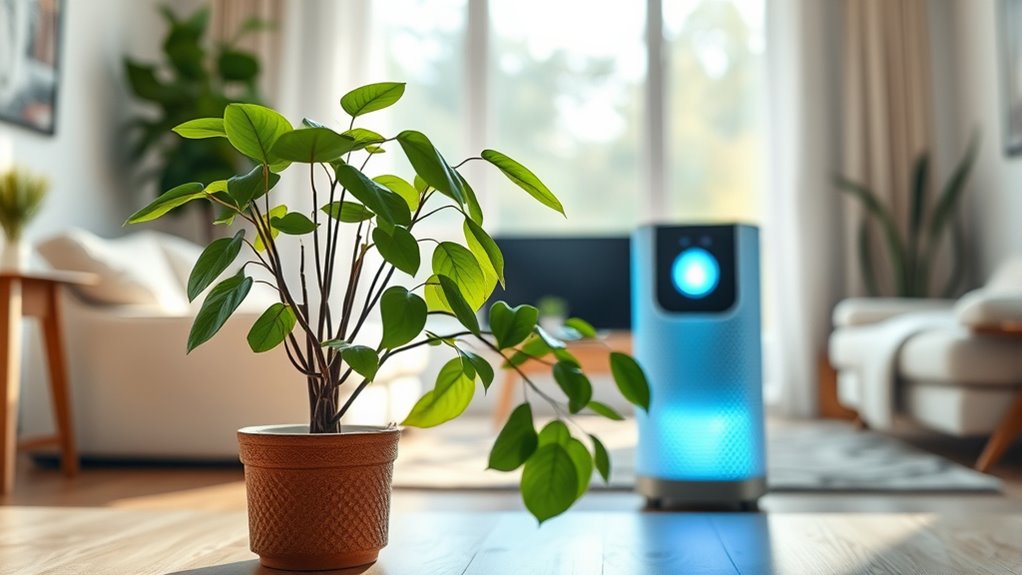
Poor air quality can considerably worsen respiratory health, making it harder to breathe and increasing the risk of infections. When indoor air contains airborne pathogens, your lungs have to work harder to filter out harmful germs, which can lead to irritation and illness. Additionally, indoor humidity levels play a vital role; too high or too low humidity can damage your respiratory defenses. Excess moisture encourages mold growth and dust mites, further irritating your airways, while dry air can dry out mucus membranes, reducing their ability to trap and eliminate pollutants. Proper HEPA filtration is essential for capturing small particles and allergens, preventing them from reaching your lungs. Breathing in contaminated air with poor humidity control strains your lungs and weakens your immune response, elevating your chances of respiratory infections and chronic issues. Implementing humidity monitoring helps maintain optimal levels and supports respiratory health. Maintaining air circulation ensures that stale air is replaced with fresh air, reducing pollutant buildup and promoting overall respiratory well-being. Effective ventilation systems are crucial in removing indoor pollutants and maintaining healthy air quality, thereby protecting your lungs and overall respiratory health.
The Connection Between Indoor Air and Allergies or Asthma
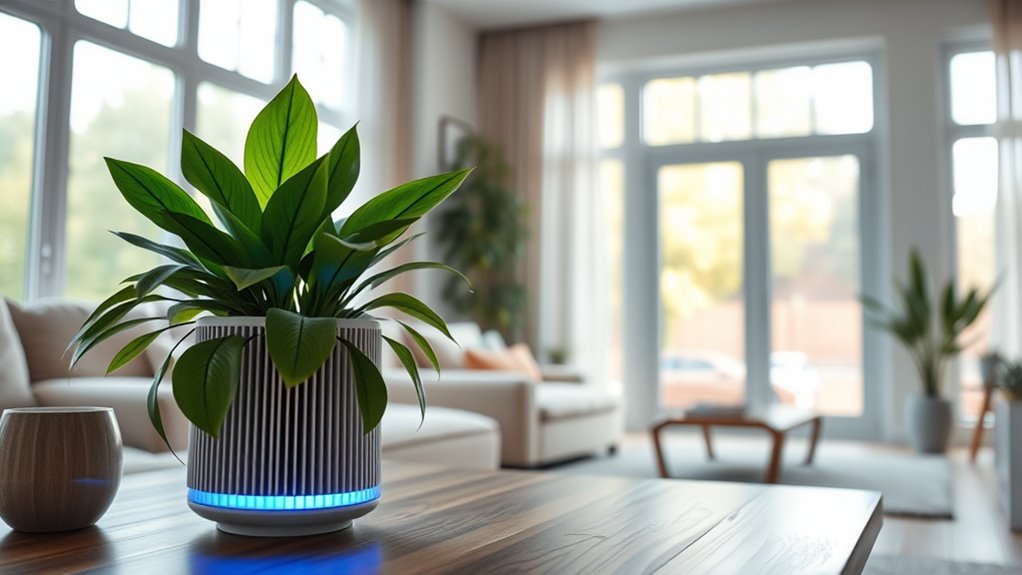
Did you know that the quality of indoor air can directly influence your allergies and asthma symptoms? Poor indoor air can introduce airborne pathogens that trigger allergic reactions or worsen asthma. It can also aggravate chemical sensitivities, making you more reactive to common household products. To reduce these risks, consider the following:
- Regularly filter and ventilate your home to remove airborne pathogens
- Use hypoallergenic and low-VOC cleaning products
- Maintain ideal humidity levels to prevent mold growth
- Keep dust and pet dander under control with frequent cleaning
Effects of Indoor Air Pollution on Immune Function

Indoor air pollution can markedly weaken your immune system, making it harder for your body to fight off infections and illnesses. Exposure to pollutants like volatile organic compounds, dust, and mold can cause immune suppression, reducing your body’s ability to detect and respond to pathogens. When your immune function is compromised, your pathogen resistance drops, increasing your risk of colds, flu, and other infections. Poor indoor air quality can trigger inflammation and stress your immune defenses, leaving you more vulnerable. By inhaling contaminated air regularly, you diminish your body’s natural ability to defend itself. Ensuring good ventilation, reducing indoor pollutants, and maintaining cleanliness are essential steps to support your immune health and keep your defenses strong against harmful pathogens.
Recognizing Signs of Indoor Air Quality Problems
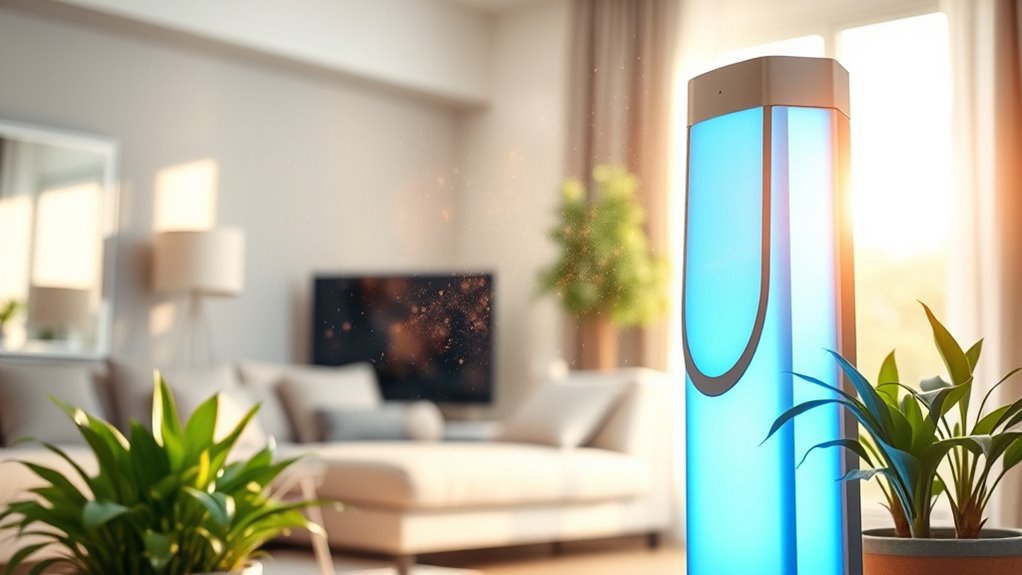
You may notice subtle signs that indicate indoor air quality issues before they become more serious. Persistent odors, unexplained allergies, or frequent respiratory discomfort can signal poor air quality. Using air quality sensors helps detect pollutants like VOCs and particulate matter early on, so you can address problems promptly. Keep an eye out for visible signs, such as mold or condensation, which often point to humidity issues. Incorporating indoor plants can also benefit air quality by naturally filtering toxins and increasing oxygen levels. Additionally, if you notice dust buildup or musty smells despite cleaning, it suggests ventilation problems that need attention. Recognizing these signs early allows you to take steps toward improving your indoor environment and protecting your health.
Practical Strategies to Improve Indoor Air Quality

Improving indoor air quality requires implementing practical strategies that effectively reduce pollutants and enhance ventilation. Start by installing air quality sensors to monitor pollutant levels and identify problem areas. These sensors provide real-time data, helping you make informed decisions about improving your environment. Incorporate indoor plantings like spider plants, snake plants, or pothos, which naturally filter airborne toxins and boost air freshness. Keep surfaces clean and dust-free to minimize allergen buildup. Avoid smoking indoors and limit the use of volatile organic compounds (VOCs) from cleaning products or paints. Regularly airing out your space by opening windows, when possible, also helps dilute indoor pollutants. Combining these strategies creates a healthier indoor environment, supporting your overall well-being.
The Role of Ventilation and Filtration Systems
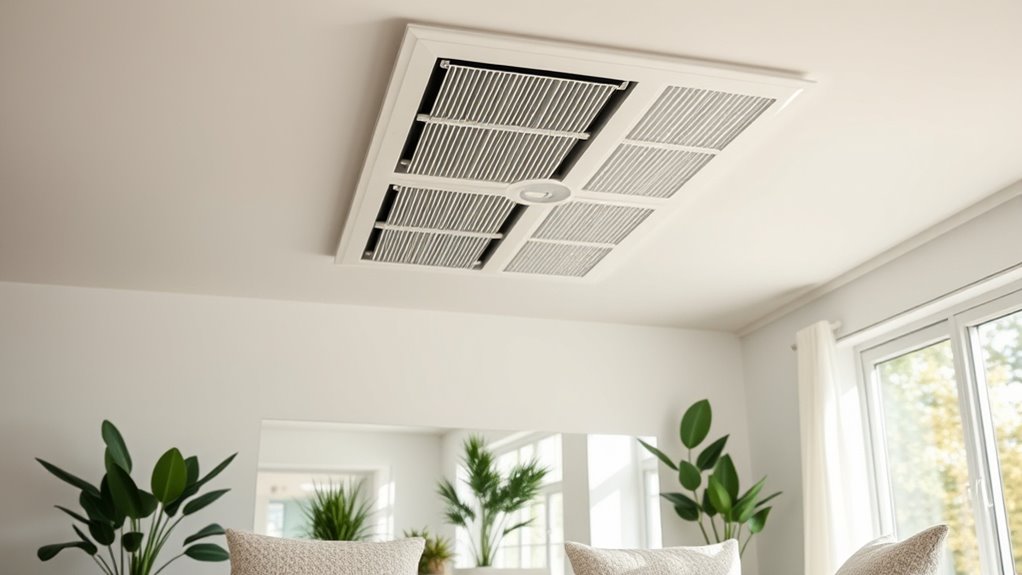
Effective ventilation and filtration systems play a vital role in maintaining healthy indoor air quality. They facilitate air exchange, removing indoor pollutants and bringing in fresh air. Proper filtration efficiency ensures airborne particles like dust, allergens, and microbes are captured effectively, reducing health risks. To optimize these systems, consider:
Effective ventilation and filtration are essential for healthy indoor air quality and reducing health risks.
- Increasing ventilation rates during high pollution periods
- Using high-efficiency particulate air (HEPA) filters
- Regularly maintaining and replacing filters
- Balancing air exchange to prevent drafts or stagnation
These strategies improve air exchange rates and filtration efficiency, creating a cleaner, healthier environment. By actively managing your ventilation and filtration systems, you markedly reduce indoor contaminants and promote better respiratory health. Great indoor air quality depends on consistently effective airflow and filtration practices.
Tips for Creating a Healthier Indoor Environment
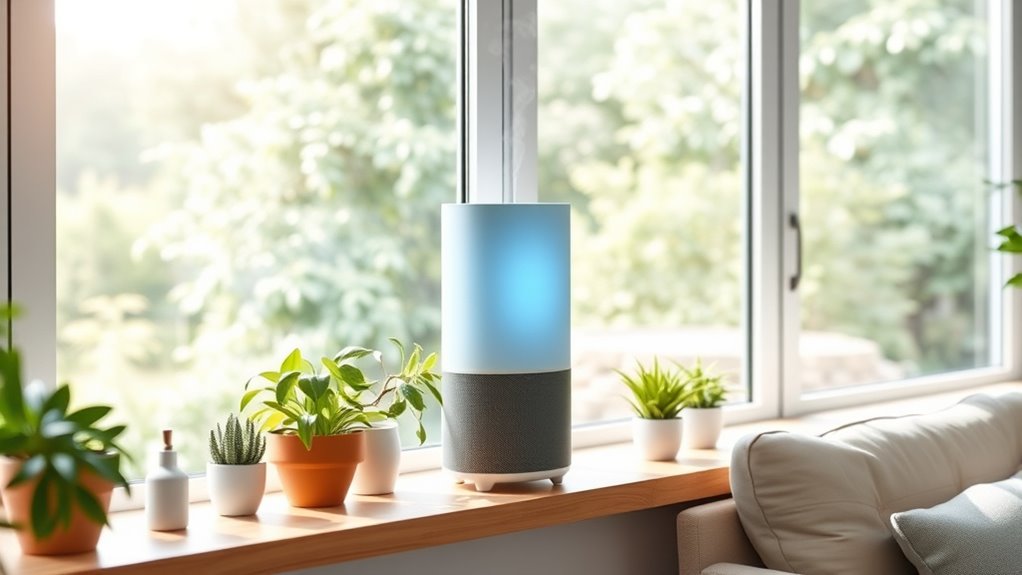
You can improve your indoor air quality by upgrading your ventilation systems to guarantee fresh air circulates effectively. Using air purifiers helps remove pollutants and allergens from the air you breathe daily. These simple steps can make a noticeable difference in creating a healthier indoor environment.
Improve Ventilation Systems
Ensuring proper ventilation is essential for maintaining healthy indoor air quality. Improving your ventilation systems enhances ventilation efficiency and promotes better air exchange, reducing indoor pollutants. To optimize your system, consider these tips:
- Regularly clean and replace filters to guarantee ideal airflow
- Increase natural ventilation by opening windows and doors when weather permits
- Upgrade to energy-efficient ventilation fans for better air circulation
- Seal leaks around windows and ducts to prevent unwanted air loss and drafts
Use Air Purifiers
Adding air purifiers to your indoor space can considerably improve air quality by capturing airborne pollutants that ventilation alone might not remove. The benefits of using an air purifier include reducing allergens, dust, pet dander, and volatile organic compounds, making your environment healthier. To maximize these benefits, focus on effective placement strategies: position the purifier in high-traffic areas or near sources of pollution, like pet zones or smoking spots. Keep it away from walls and furniture to ensure proper airflow. Regularly change filters to maintain peak performance. Remember, the right placement and maintenance can greatly enhance the purifier’s effectiveness, helping you breathe cleaner, healthier air every day.
Frequently Asked Questions
How Often Should I Test My Indoor Air Quality?
You should test your indoor air quality at least once every three to six months. Regular air quality monitoring helps identify issues related to poor ventilation strategies or pollutants. If you notice musty odors, allergies, or respiratory issues, increase testing frequency. Maintaining good ventilation and conducting routine checks guarantee your indoor air remains healthy. Staying proactive with air quality assessments keeps your environment safe and comfortable.
Can Indoor Plants Improve Air Quality Effectively?
Sure, because who wouldn’t want a jungle in their living room, right? Indoor plants do offer plant benefits like adding aesthetic charm and, surprisingly, air filtration. They can absorb some toxins and boost humidity, but don’t rely solely on them for clean air. Remember, their air filtration is gentle and limited—think of them as delightful sidekicks rather than air purifiers. For truly healthy indoor air, consider proper ventilation and air quality testing.
What Are Cost-Effective Ways to Reduce Indoor Pollutants?
To reduce indoor pollutants cost-effectively, you can try DIY filtration using simple air purifiers or homemade filters, which are budget-friendly and effective. Additionally, improving ventilation strategies—like opening windows regularly or using exhaust fans—helps dilute indoor pollutants and freshen the air. These strategies require minimal investment but can notably improve your indoor air quality, making your space healthier without breaking the bank.
Do Air Purifiers Eliminate All Indoor Air Contaminants?
Air purifiers don’t eliminate all indoor air contaminants due to their limitations. They effectively reduce many pollutant types like dust, pollen, and some bacteria, but struggle with gases, volatile organic compounds (VOCs), and certain viruses. You should understand these air purifier limitations and combine them with proper ventilation and source control for better indoor air quality. Relying solely on an air purifier won’t fully remove every indoor contaminant.
How Does Humidity Affect Indoor Air Quality and Health?
Humidity levels directly impact indoor air quality and your health. When humidity is too high, it creates an ideal environment for mold growth, which can cause respiratory issues and allergies. Conversely, low humidity can lead to dry skin and irritate your respiratory system. Maintaining balanced humidity levels helps prevent mold and keeps the air healthier, reducing potential health problems and making your indoor environment more comfortable.
Conclusion
Improving your indoor air quality isn’t just about avoiding pollutants; it’s about creating a healthier environment that subtly influences your well-being. As you adopt better ventilation and cleaning habits, you might notice how your mood and energy levels improve, almost unexpectedly. Sometimes, small changes lead to surprising benefits—like clearer breathing when you least expect it. Remember, a cleaner indoor space isn’t just coincidence; it’s a conscious step toward better health and overall comfort.

